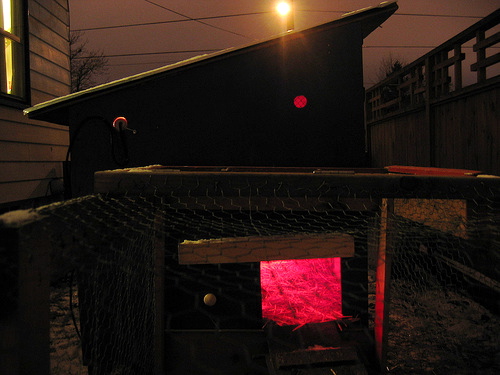
reference-image, l
(post, Caroline Cummins)
It doesn't usually get very cold west of the Cascade Mountains. Damp and dreary, certainly, but freezing? Not often. So while our three chickens weren't exactly thrilled about the slow, sloggy arrival of winter (and neither were we, since less light and cooler temperatures mean fewer eggs), they were still content to snooze in their coop by night and peck around their increasingly muddy run by day. [%image reference-image float=left width=350 caption="The coop and run in the snow."] When it does snow here, it's generally a light, wet smearing of white stuff that typically melts in a few hours. Every few years, we get A Big Snowstorm, which usually means several gloppy inches, inspiring panic in civilians and glee in weather forecasters. But what the Pacific Northwest got on Sunday was out of the ordinary. First, it snowed — all day, in itself strange. Second, it was dry — powdery fluff that blew off rooftops and along streets, looking more like fake Hollywood snow than the gooey gunk we usually get. Third, after it snowed, the temperature continued to drop, which meant that instead of melting, the snow (now crushed by cars into ice) stuck around. My husband spent a good part of Sunday trying to make our chickens more comfortable. Granted, these aren't Chihuahuas — they're birds covered in dense layers of feathers, so they weren't exactly sitting on their roost with chattering beaks. But hey, it wasn't just freezing out there, it was below freezing. [%image tuffystevie float=right width=350 caption="Tuffy (and Stevie's head, right) inside the heat-lamped coop."] So my spouse did three things: He moved the entire coop setup so it'd be in a sunnier part of the yard. He put food and water inside the coop so the birds wouldn't have to go outside to eat (and die of thirst, since their water dispenser, naturally, froze solid). And he rigged up a thermometer and heat lamp inside the coop so the birds could be cozy. This last was the Geek Adventure. Hardware stores sell outdoor timers for, say, Christmas lights, so you don't have to turn your outdoor lights on and off manually. What we wanted, however, was a somewhat trickier gadget: a thermostat that would turn on the heat lamp once the temperature fell below freezing. (We know these things exist, because our chicken-keeping neighbors three blocks away have one.) Of course, none were available to desperate shoppers on a snowy Sunday. [%image "hades coop" float=left width=350 caption="Chicken coop, or gateway to Hades?"] So instead, my husband propped up inside the coop the heat lamp we'd used to keep the chickens warm when they were babies, and stuck a thermometer against the inside wall above the roost. The thermometer, a housewarming gift, came equipped with a remote reader, a doohickey that displays temperature readings of both wherever you place the thermometer plus wherever you happen to be reading the doohickey (in our case, inside our house). We watched as the reader began tracking both our own house (cozy in the mid-60s) and the inside of the coop (not so cozy in the high 20s). The coop temperature began to go up — and up, and up. "Maybe the coop's on fire," my husband suggested. (There's a lot of straw inside the coop, after all, and the coop is just wood with a metal roof.) We dashed outside to inspect — and realized that the chickens, crowded together on their roost, were pressing firmly against the thermometer, spiking its temperature readings. No fire. With time, the thermometer settled into ordinary readings — mostly in the 30s, not exactly toasty but warm enough for the birds. Occasionally my husband would check to make sure the heat lamp wasn't incinerating the coop, but after a day or so, he decided it seemed safe enough. And by Tuesday, with sunshine warming the coop as well as the lamp, the chickens were practically basking in the high 40s. Whew.

reference-image, l

hades coop, l

tuffystevie, l